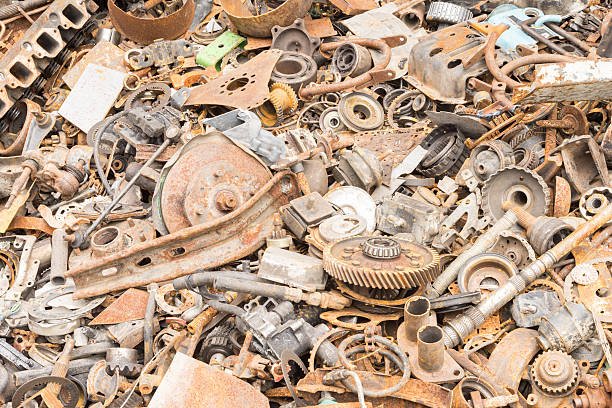In today’s industrial era, the demand for sustainable resources and eco-friendly practices is
greater than ever. Among the materials driving recycling and sustainability, iron scrap holds a
crucial position. Iron has been central to human progress for centuries, and even today it
remains one of the most widely used metals in industries ranging from construction to
automotive.

With growing awareness of environmental preservation, the importance of iron scrap has only
increased. It is now recognized as a vital resource for both economic growth and ecological
balance. Standing out in this field, A Sai Scrap has earned a reputation as a trusted leader in
providing reliable, transparent, and efficient iron scrap solutions with a customer-first approach.
What is Iron Scrap?
Iron scrap refers to discarded or leftover iron materials that are no longer in primary use but can
be recycled and transformed into new raw material. This may include damaged tools, old
machinery, construction waste, automobile parts, household items, and industrial by-products.
Instead of being wasted, iron scrap is collected and processed in recycling plants to re-enter the
production cycle.
Iron scrap is mainly classified into two categories:
- Ferrous Scrap – Derived from iron and steel, such as beams, machinery, ship plates, and
vehicle parts. - Non-Ferrous Scrap – Metals that do not contain iron (less relevant here but often mixed with
ferrous materials).
At A Sai Scrap, both small- and large-scale ferrous scrap is collected, sorted, and processed to
ensure maximum recycling value.
The Economic Value of Iron Scrap
Iron scrap is not just industrial waste—it is an economic asset. Recycling iron significantly
reduces the need for mining fresh iron ore, cutting costs for industries while maintaining material
quality.
For steel manufacturers, iron scrap offers a cost-effective raw material alternative. Globally, the
scrap recycling industry is worth billions, with iron and steel scrap making up the largest share.
Nations like India, China, and the United States are among the largest contributors, driven by
massive industrial and construction activities.
For local businesses and dealers, iron scrap also serves as a steady source of income. A Sai
Scrap strengthens this ecosystem by offering fair prices, transparent dealings, and a consistent
supply chain for industries.
Environmental Benefits of Iron Scrap
One of the greatest advantages of iron scrap recycling is its - environmental impact – Mining fresh iron ore requires extensive energy, land use, and results
in significant emissions. Recycling addresses these issues: - Energy Savings – Producing steel from scrap consumes up to 60–70% less energy than
processing raw ore. - Lower Pollution – Recycling reduces greenhouse gas emissions, water use, and air pollution.
- Less Landfill Waste – Old iron products are reused instead of being dumped in landfills.
- Sustainability – Recycling helps conserve natural resources for future generations.
At A Sai Scrap, eco-friendly practices are at the core of operations, ensuring recycling benefits
both industries and the environment.
Sources of Iron Scrap
Iron scrap originates from multiple sources, including: - Construction and Demolition – Beams, rods, reinforced structures, and steel sheets.
- Automotive Industry – Vehicle bodies, spare parts, engines, and metal frames.
- Household Goods – Appliances, utensils, furniture, and tools.
- Industrial Waste – Old machinery, tools, and by-products.
- Shipbreaking– Large volumes of iron and steel from dismantled ships.
A Sai Scrap collaborates with all these sectors, offering comprehensive collection and recycling
services.
The Process of Recycling Iron Scrap
The transformation of iron scrap into reusable material involves several steps: - Collection – Gathering scrap from households, industries, and construction sites.
- Sorting & Separation – Using magnets and advanced techniques to separate iron from other
materials. - Processing & Shredding – Cleaning and breaking down scrap into manageable pieces.
- Melting – Scrap is melted at high temperatures in furnaces.
- Purification – Impurities are removed to produce high-quality recycled metal.
- Solidification – The molten metal is cast into sheets, bars, or specific shapes for reuse.
Through advanced systems and expert handling, A Sai Scrap ensures this process is efficient,
reliable, and yields high-quality materials.
Iron Scrap and the Circular Economy
The concept of a circular economy emphasizes reusing and recycling resources instead of the
traditional “take-make-dispose” model. Iron scrap plays a vital role in this transition.
By recycling iron, industries minimize dependence on limited natural resources, lower costs, and
promote responsible production. Companies like A Sai Scrap make this vision a reality by
ensuring waste re-enters the production cycle sustainably.
Challenges in Iron Scrap Management
Despite its potential, the iron scrap industry faces challenges:
Unorganized Collection Systems in certain regions. - Quality Issues due to rust, coatings, or impurities in scrap.
- Price Volatility influenced by global supply and demand.
- Low Awareness among individuals about selling scrap instead of discarding it.
A Sai Scrap addresses these challenges through structured collection, fair trade practices, and
public awareness initiatives.
The Future of Iron Scrap
The future of iron scrap recycling is bright. With ongoing urbanization, industrial expansion, and
infrastructure development, the demand for steel and iron is set to grow. At the same time,
global sustainability goals will push industries to rely more on recycled scrap.
Innovations like automated sorting, smart recycling facilities, and AI-driven scrap management
will further streamline the process. Positioned at the forefront of this evolution, A Sai Scrap is
committed to maximizing the value of recycled materials.
Conclusion
Iron scrap is not just waste—it is valuable resource powering industries, saving energy,
protecting the environment, and boosting the economy. From construction sites to households,
iron scrap surrounds us every day, ready to be recycled and reused.
By promoting awareness, improving recycling systems, and investing in advanced technologies,
A Sai Scrap continues to unlock the true potential of iron scrap. Ultimately, adopting scrap
recycling today ensures a cleaner, greener, and more sustainable tomorrow.
